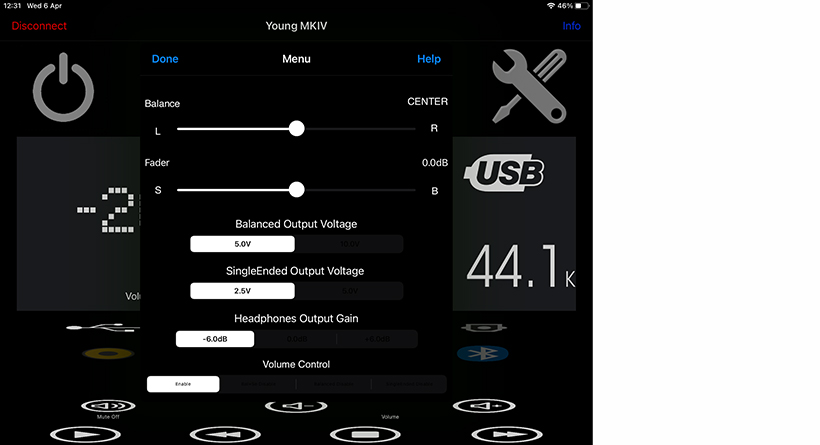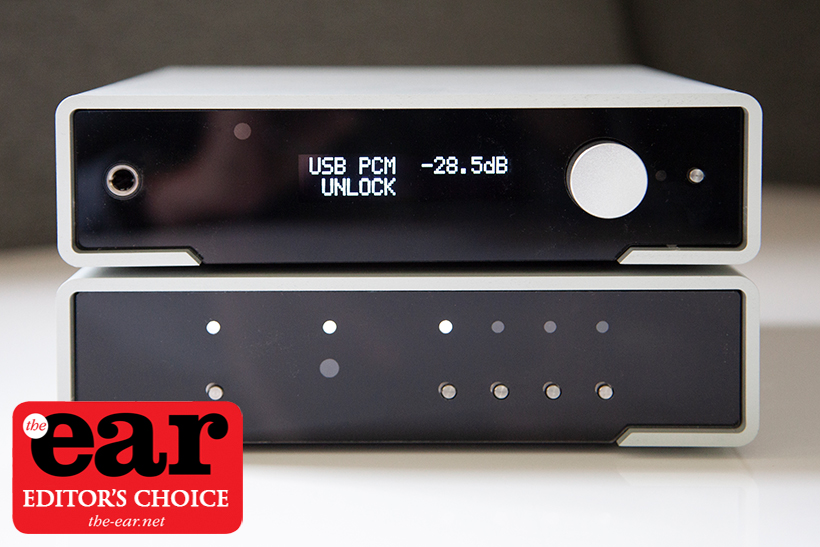It’s not clear when looking at a single product from M2Tech’s Rockstars range why they have a particular name, but gather the model names together and you have the Crosby power amplifier, Nash phono preamplifier and Young DAC as well as a Joplin ADC/phono stage and a Mitchell active crossover among others. Stills doesn’t seem to have made an appearance yet, there must have been an argument over musical differences.
The Young DAC was the first Rockstar to see the light of production over a decade ago, it was also one of the first converters to offer 32-bit/384kHz PCM at the time yet looked very similar to the latest version. This is a compact converter that measures 20cm (8 inches) wide yet offers both digital and analogue inputs of most varieties including I2S, Bluetooth, RCA and XLR in- and outputs, and incorporates a preamplifier. The compact size is achieved by leaving the power supply outboard in the form of a wallwart or the optional Van Der Graaf MkII which inhabits a box of the same size.

In the specs department it will decode PCM up to 32-bits at 768kHz, I don’t think there are many that go higher, and DSD up to DSD512. It will decode all the usual formats as well as MQA for users with access to Tidal Masters streaming, the highest res albums on the service. The specs here really are the tip of the tech iceberg however, this DAC is stacked with features rarely seen on other converters, not least is app control via Bluetooth; the M2Tech Young app will let you adjust and control pretty well all the parameters of this device. You can do the same via the front panel display but that involves getting off the sofa.
Functions that can be adjusted via app or screen include input selection, balance, independent volume control or full output from RCAs and XLRs, voltage level from those outputs, headphone output gain, DSD FIR filter from a choice of two, phase and the choice between DAC filters that either reduce THD and noise or increase the signal to noise ratio. Apparently the first being best for high level recordings and S/N for those with wide dynamic range, THD+N is the default.

A fader option allows the level from RCA and XLR preamp outputs to vary by up to 6dB in half decibel steps which means that power amps of different gain can be used together in the one system. You can also adjust maximum output up to 10Vrms which seems high but could be useful with some power amp/speaker combinations. Headphone users will appreciate the variable gain available through the quarter inch jack which comes in three flavours and spans 12dB. The I2S input should also be mentioned, this uses the PS Audio protocol and can be used for an external clock, here there are two settings to suit different clock frequencies, 1:1 and 2:1, the latter halving the master clock frequency for higher frequency inputs.
The Van Der Graaf MkII is a multi output power supply for up to four M2Tech components, that said the output voltage can be 5V, 9V or 15V and therefore this PSU could be paired with components from other brands. It has outputs on coaxial (9V or 15V) and four pin XLR (5V + 15V) sockets, there are switches to select which output is live on the front.

Sound quality
The Young MkIV was in and out of the system over an extended period of months, which is not the best way to analyse a product but the fact that I kept going back to it is a sign that it worked well, neither did it have any sonic or operational foibles that got in the way of enjoying the music. Something I would much rather do than make comparisons and write notes. But I managed to make a few, initially listening was done with the wall-wart power supply that comes with the DAC and using the Silent Angel Munich M1 streamer plus its own F1 upgrade power supply as a source. Here I dropped in the M2Tech in place of the M1’s onboard DAC and got a big jump in detail resolution, the sound gaining precision and clarity to the extent that the decay on piano became far more obvious. Depth of image was also a strong point, a factor of the significant detail resolution that the Young MkIV delivers albeit not at the expense of coherence, this is a tremendously fluent and well timed converter. I particularly enjoyed Maria Kannegaard’s piano playing on the trio album Sand I En Vik where even the passages that usually find my mind drifting off proved engaging, the insistence of her left hand when things take off became that much more exciting.
With the heavier beats of Deadmau5’s Seeya the tight solidity of the kick drum sound was more appealing than usual, there is clearly very little in the way of time smear being produced by this DAC, it is always bang on the money and, equally important, doesn’t lean on the leading edges to enhance the sense of immediacy. Quite a few digital components do this because it sounds impressive in the short term, the more you listen however the more obvious it becomes that this is a character of the electronics that is being imposed on the sound. Which is not high fidelity nor is it going to sound good with all forms of music, especially those featuring acoustic instruments and voices.

I added the Van Der Graaf MkII power supply to try this DAC with a more ambitious streamer in the form of Aavik’s S-180 and got a relaxed, sound with very low perceived distortion and extremely good imaging. The presentation being less etched but more interesting and engaging, it was clearly more musically coherent and that made the music more emotionally powerful. Nick Cave’s Jesus Alone had plenty of weight that reinforced the power of the song while the rhythmic density of Here Comes De Honey Man (Herbie Hancock) was delivered in thrilling and totally fluent fashion. Likewise the heavy grooves of Binker & Moses (sax and drums) became a lot more approachable, the intensity of the playing is as strong as ever but the low distortion and excellent timing of this DAC means that the music makes sense, your brain doesn’t have to work overtime to enjoy it.
I compared the Young DAC MkIV to a number of more pricey converters during its tenure and rarely found anything that could give it serious competition. It has a relaxed, calm presentation with excellent depth of tone and finely nuanced detail that reflects the quality of the incoming signal with ease. Great recordings sound truly great, open, dynamic and melodic when the music requires. All of which inspired me to try using it as a preamplifier.

More than nine out of ten onboard volume controls in DACs have a negative effect on sound quality, most are clearly inferior to even reasonably priced preamplifiers and the fixed output is almost always the best way to go. This M2Tech breaks that mould by having a very decent preamplifier section indeed, it’s not as effortless as a £12k Townshend Allegri Reference but you wouldn’t expect it to be, little is. With the Van Der Graaf providing power it is at least as good as standalone preamplifiers at the price point and delivers an awful lot of detail in a precise and musically enchanting fashion. It reveals the beauty of the Tord Gustavsen Trio’s music in no uncertain terms, there is so much space in the recording and this is easy to hear alongside powerful dynamics and room filling stereo solidity. Cymbals are particularly well served as are voices and when several instruments and voices are combined they can be easily separated yet are presented as a coherent whole. I was also impressed to find that even the analogue input on the Young MkIV sounds good, it’s crisp and detailed and once again reflects the nature of the recording very effectively.
Encouraged by Andy Whittle of Rogers to try playing YouTube through the system I first tried a long USB cable from a laptop but that didn’t work so I went for the Young MkIV’s Bluetooth option and was pleasantly surprised. Sound quality varies significantly on that platform but the good ones are surprisingly good, Mavis Staples and Levon Helm playing This May be the Last Time for instance is beautifully open and live sounding and there are many more.
Conclusion
That this DAC is presented in a small box with relatively straightforward styling undermines that fact that it is a remarkably good sounding and capable converter, especially when combined with the upgrade power supply. If the pairing were encased in 20 kilos of machined aluminium you would expect the price to be at least four times what’s being asked. The feature count is greater than virtually all other DACs and the sound quality puts the Young MkIV and Van Der Graaf as the same footing as alternatives at far higher prices. Take it from me, this is an audiophile bargain.


